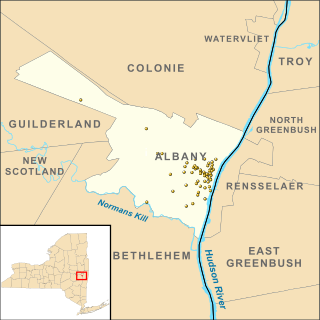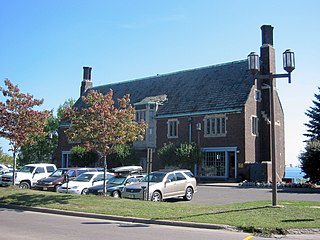
Duluth Central High School, also referred to as Central High School, was a secondary school in Duluth, Minnesota. The original building at the intersection of Lake Avenue and Second Street first opened in 1893 and closed in 1971, being used as office space until it was converted to apartments in 2024. On October 19, 2004, this building was given the official name Historic Old Central High School.

Glensheen, the Historic Congdon Estate is a 20,000 square foot mansion in Duluth, Minnesota, United States, operated by the University of Minnesota Duluth as a historic house museum. Glensheen sits on 12 acres of waterfront property on Lake Superior, has 39 rooms and is built in the Jacobean architectural tradition, inspired by the Beaux-Arts styles of the era. The mansion was constructed as the family home of Chester Adgate Congdon. The building was designed by Minnesota architect Clarence H. Johnston Sr., with interiors designed by William A. French Co. and the formal terraced garden and English style landscape designed by the Charles Wellford Leavitt firm out of New York. Construction began in 1905 and was completed in 1908. The home cost a total of $854,000, equivalent to more than $22 million in 2017. The home is a crowning example of design and craftmanship of the Midwestern United States in the early 20th century.

Endion station is a former train station in Duluth, Minnesota, United States. It was built in 1899 to serve the Endion neighborhood but was relocated to Canal Park in 1986 to make way for expansion of Interstate 35. Passenger service through the station had ceased in 1961 and freight service in 1978.

Fire Station No. 1 is a former fire station in the Central Hillside neighborhood of Duluth, Minnesota, United States. The two-building complex was constructed in 1889. It was one of the first fire stations in Duluth, built as the city transitioned from a volunteer fire department to a professional municipal agency. The station consists of a Romanesque Revival engine house and a plainer stable/shop building which wraps around it in an L.

The F. Scott Fitzgerald House, also known as Summit Terrace, in Saint Paul, Minnesota, United States, is part of a group of rowhouses designed by William H. Willcox and Clarence H. Johnston Sr. The house, at 599 Summit Avenue, is listed as a National Historic Landmark for its association with author F. Scott Fitzgerald. The design of the houses was described as the "New York Style" in which unit was given a distinctive character found in some rowhouses in eastern cities. Architecture critic Larry Millett describes it as "A brownstone row house that leaves no Victorian style unaccounted for, although the general flavor is Romanesque Revival." The Fitzgerald house is faced with brownstone and is two bays wide with a polygonal two-story window bay on the right, and the entrance, recessed under a round arch that is flush with the bay front, on the left. The mansard roof has a cross-gable with two round-arch windows and decorative finials.

The Broomfield Rowhouse is located at 2502-2504 Lake Street in the Near North Side neighborhood of Omaha, Nebraska. It was designed by African American architect Clarence W. Wigington, who was later regarded as a master in his field. His design for the house won a 1909 Good Housekeeping competition. The house is listed on the National Register of Historic Places.

The Steele County Courthouse is the seat of government for Steele County, located in Owatonna, Minnesota, United States. It was built in 1891. The courthouse is a three-story Austin red-brick building with red mortar, accented with Lake Superior brown stone. It was designed by T. Dudley Allen of Minneapolis in a Romanesque Revival and Italianate style, featuring corner towers, a turret, and a large clock on four sides. Windows are arched and a statue representing Mercy, Law, and Justice sits above the north face of the building. Polished granite columns support double arches at the entrances. The interior is decorated with wainscoting, woodwork, and an ornate oak staircase. The courthouse was listed on the National Register of Historic Places in 1976 for having local significance in the themes of architecture and politics/government. It was nominated for its Romanesque Revival architecture and long service as Steele County's government seat.

This is a list of the National Register of Historic Places listings in Saint Louis County, Minnesota. It is intended to be a complete list of the properties and districts on the National Register of Historic Places in Saint Louis County, Minnesota, United States. The locations of National Register properties and districts for which the latitude and longitude coordinates are included below, may be seen in an online map.

Oliver Green Traphagen was an American architect who designed many notable buildings in Duluth, Minnesota, during the late 19th century and in the Territory of Hawaii during the early 20th century. Among his most famous landmarks are the Oliver G. Traphagen House in Duluth, called the Redstone, and the Moana Hotel in Honolulu, both of which are on the National Register of Historic Places, as are several other buildings he designed.

The Honolulu Fire Department (HFD) operates their 44 Fire Stations on the Island of Oahu, and in and around Honolulu. Seven current or former stations are on the National Register of Historic Places, of which five are still in use today as fire stations.

There are 77 properties listed on the National Register of Historic Places in Albany, New York, United States. Six are additionally designated as National Historic Landmarks (NHLs), the most of any city in the state after New York City. Another 14 are historic districts, for which 20 of the listings are also contributing properties. Two properties, both buildings, that had been listed in the past but have since been demolished have been delisted; one building that is also no longer extant remains listed.

The Gerald W. Heaney Federal Building, United States Courthouse and Custom House in Duluth, Minnesota, is a courthouse of the United States District Court for the District of Minnesota. Completed in 1930, it is part of the Duluth Civic Center Historic District, listed on the National Register of Historic Places in 1986. In 2007 the United States Congress passed an act to rename the building for former Circuit Court judge Gerald Heaney. It was enacted into law that same year.

The Duluth Civic Center Historic District is a historic government complex in Duluth, Minnesota, United States. It includes the St. Louis County Courthouse, Duluth City Hall, and the Gerald W. Heaney Federal Building. The complex was designed by urban planning pioneer Daniel Burnham in 1909 and constructed over the next twenty years. It was listed as a historic district on the National Register of Historic Places in 1986 for its state-level significance in the themes of architecture and community planning and development. It was nominated for its associations with Burnham and the City Beautiful movement.

Munger Terrace is an architecturally significant rowhouse in the Central Hillside neighborhood of Duluth, Minnesota, United States. It was designed by Oliver G. Traphagen and Francis W. Fitzpatrick and built from 1891 to 1892, originally containing eight luxury townhomes. Munger Terrace was listed on the National Register of Historic Places in 1976 for its local significance in the theme of architecture. It was nominated for being Duluth's finest example of Châteauesque architecture applied to an apartment building.

The Jumel Terrace Historic District is a small New York City and national historic district located in the Washington Heights neighborhood of Manhattan, New York City. It consists of 50 residential rowhouses built between 1890 and 1902, and one apartment building constructed in 1909, as the heirs of Eliza Jumel sold off the land of the former Roger Morris estate. The buildings are primarily wood or brick rowhouses in the Queen Anne, Romanesque and Neo-Renaissance styles. Also located in the district, but separately landmarked, is the Morris-Jumel Mansion, dated to about 1765.

The Hartley Building is a historic office building in Duluth, Minnesota, United States. It was designed by architect Bertram Goodhue of New York City and built in 1914. The Hartley Building was listed on the National Register of Historic Places in 1989 for having local significance in the theme of architecture. It was nominated for its exemplary Tudor Revival architecture and its status as one of four local buildings designed by Goodhue, the only nationally recognized architect to produce multiple commissions in early Duluth.

The historic Duluth Public Library is a former Carnegie library building at 101 West Second Street in Duluth, Minnesota, United States. It was constructed in 1902 as the first purpose-built facility of the Duluth Public Library. It was listed on the National Register of Historic Places in 1978 for its local significance in the themes of architecture and education. It was nominated for its Neoclassical architecture and association with early community education efforts.

The Kitchi Gammi Club is the oldest incorporated club in the U.S. state of Minnesota, founded in 1883. Its historic clubhouse in Duluth, Minnesota, was built from 1912 to 1913. In 1975 the clubhouse was listed on the National Register of Historic Places for its state-level significance in the theme of architecture. It was nominated for its fine Georgian/Gothic Revival design by Bertram Goodhue and its superlative craftsmanship.

Endion School is a former school building in the East End/Endion neighborhood of Duluth, Minnesota, United States. Built in ornate Richardsonian Romanesque style with a unique design on a prominent hilltop site, it has been a local landmark since its construction in 1890. Endion School was listed on the National Register of Historic Places in 1983 for its local significance in the theme of architecture. It was nominated as the finest surviving example of Duluth's Late Victorian school buildings.

Cathedral Historic District, originally the Sioux Falls Historic District, is located in Sioux Falls, South Dakota. Named for its centerpiece and key contributing property, the Cathedral of Saint Joseph, the district covers the neighbourhood historically known as Nob Hill, where multiple prominent pioneers, politicians, and businessmen settled in the late 19th and early 20th centuries. These homes primarily reflect Queen Anne and Mediterranean Revival architectural styles. In 1974, the neighborhood was listed as a historic district on the National Register of Historic Places (NRHP); at the time of this listing, there were 223 buildings, not all contributing, within the district's boundaries. The district was enlarged in 2023.

























